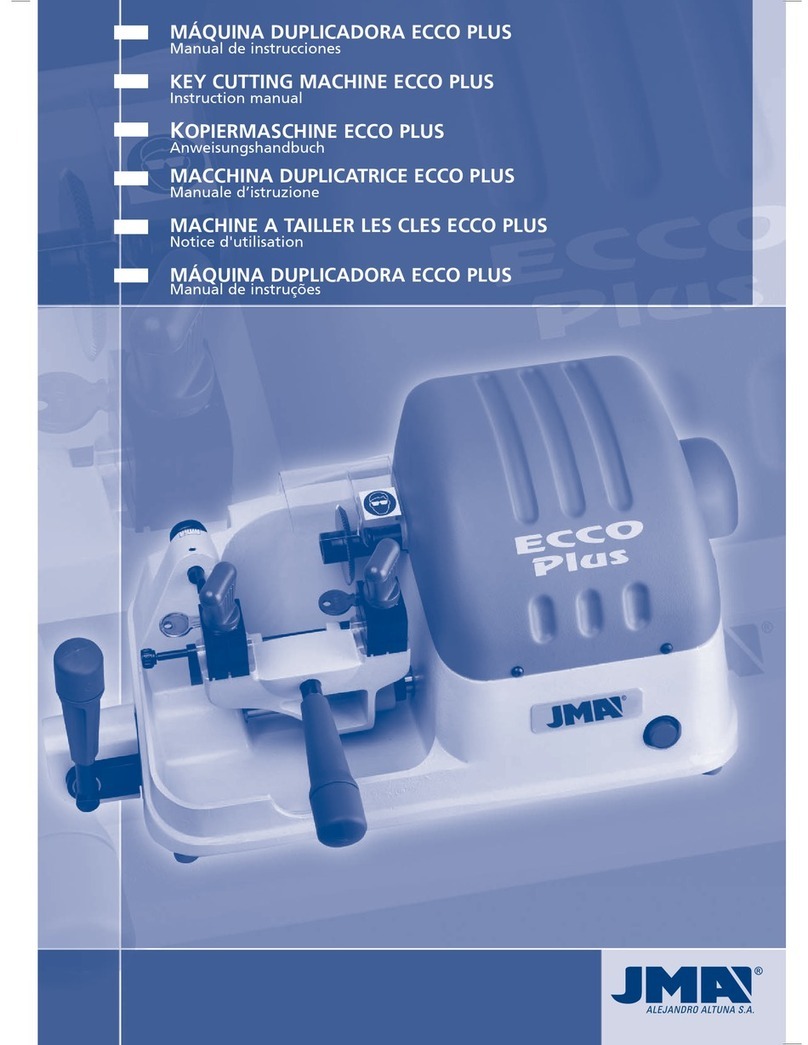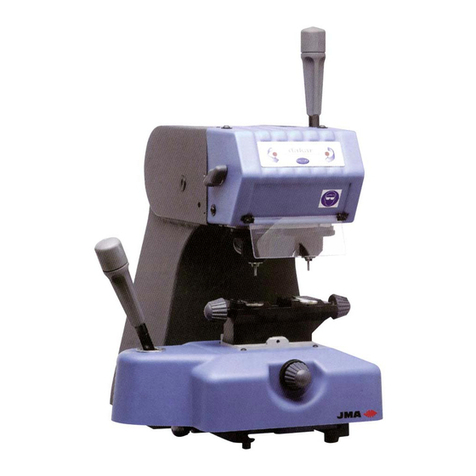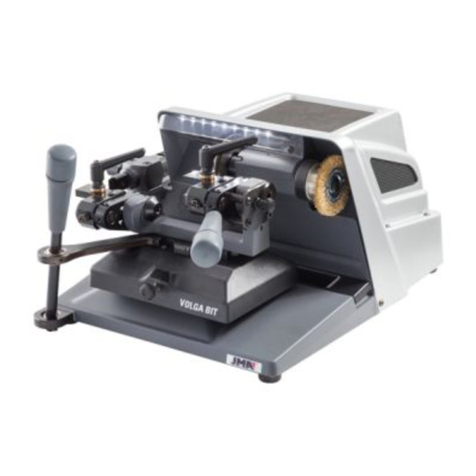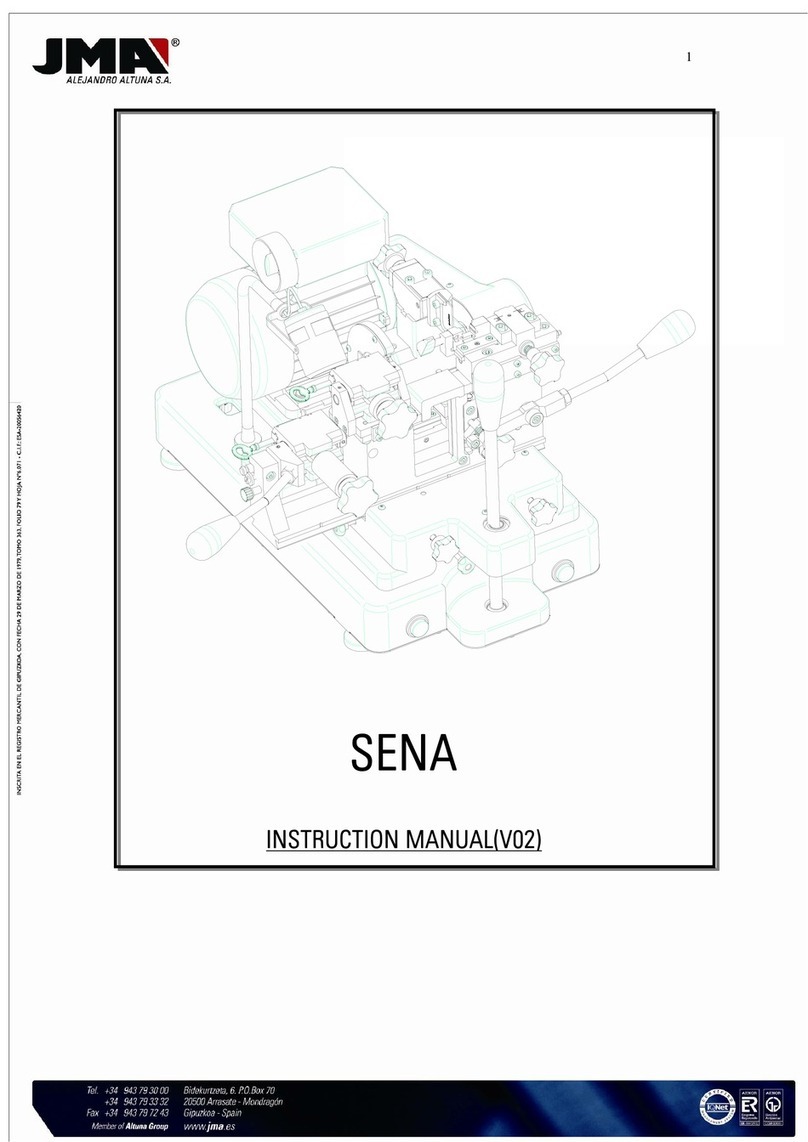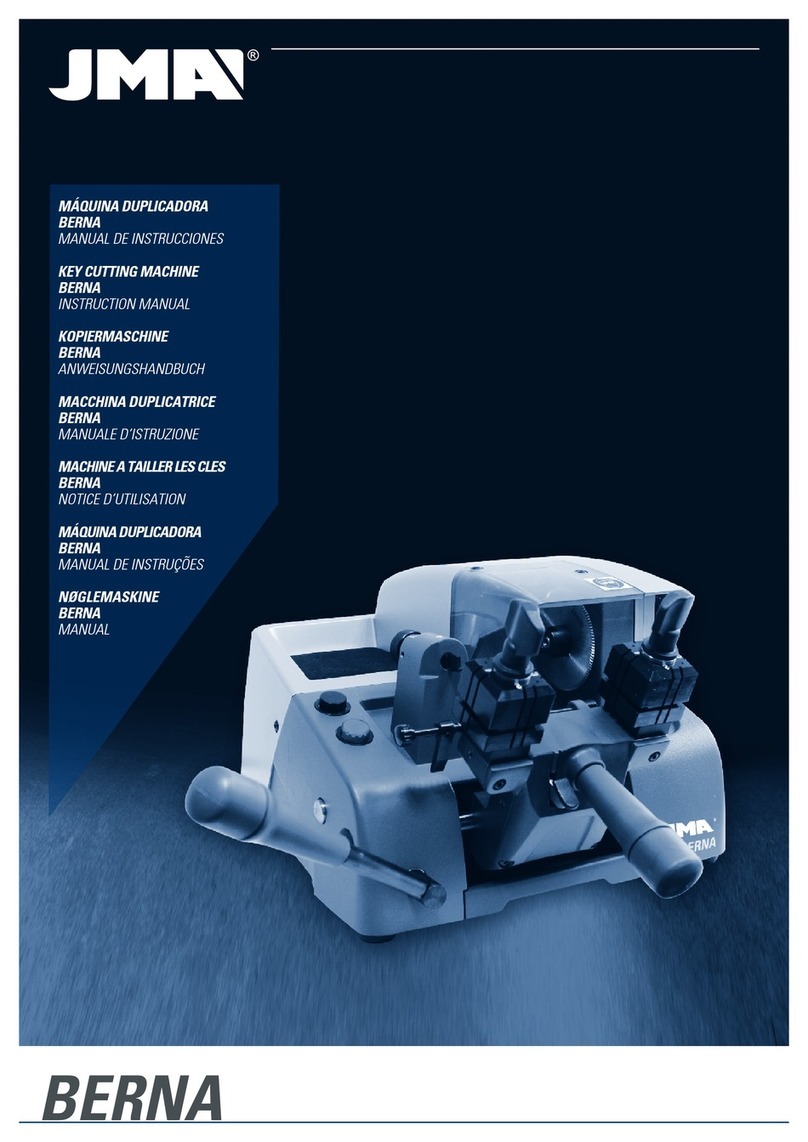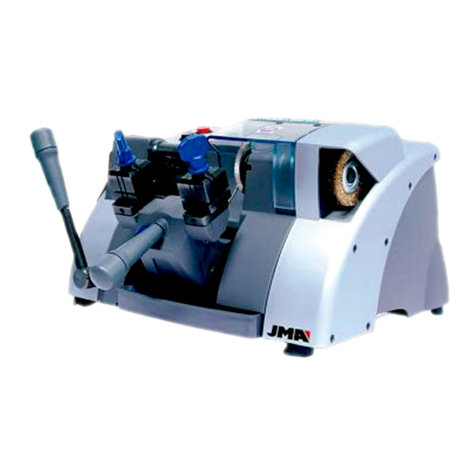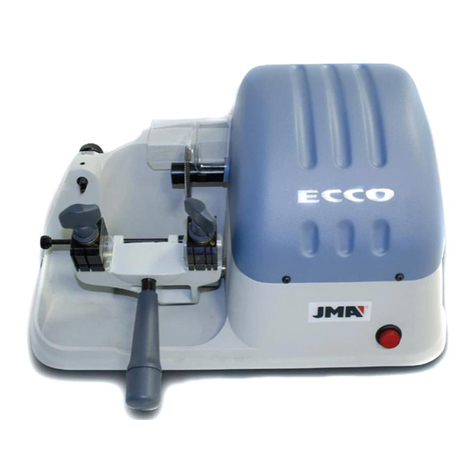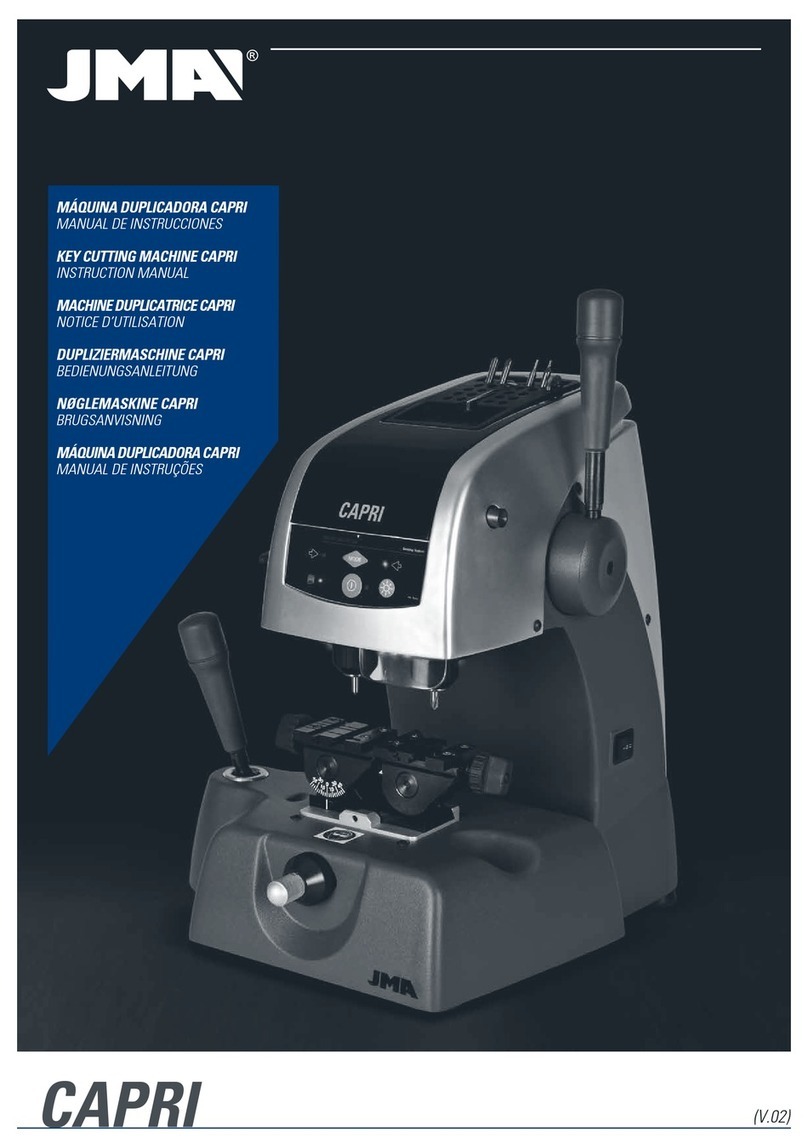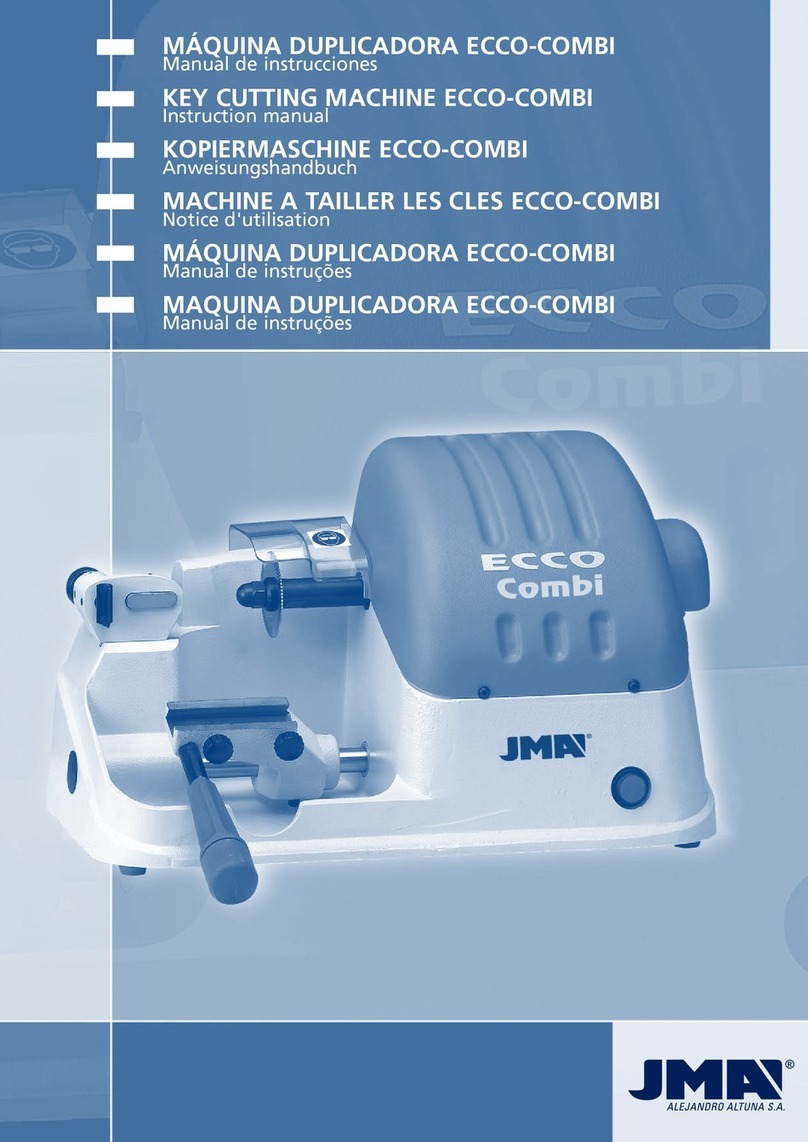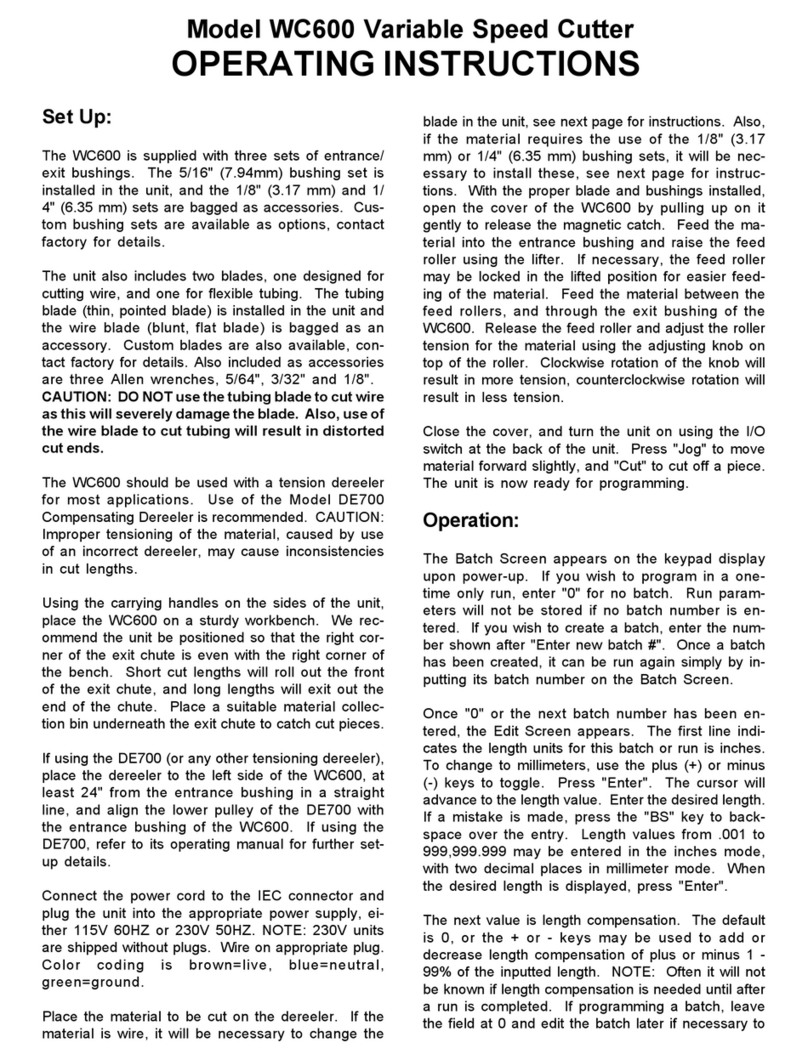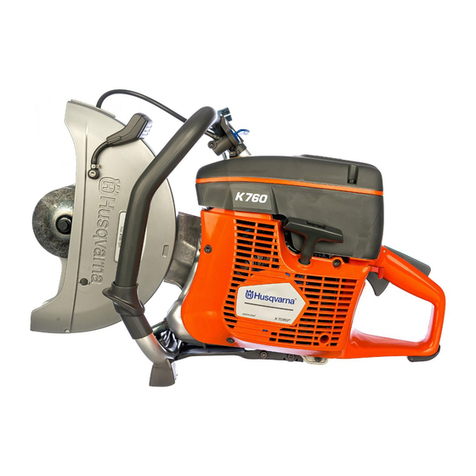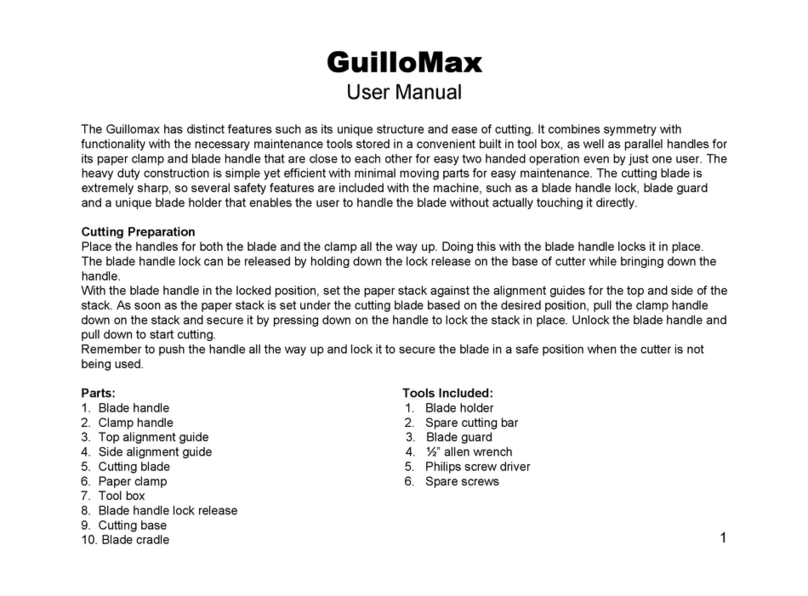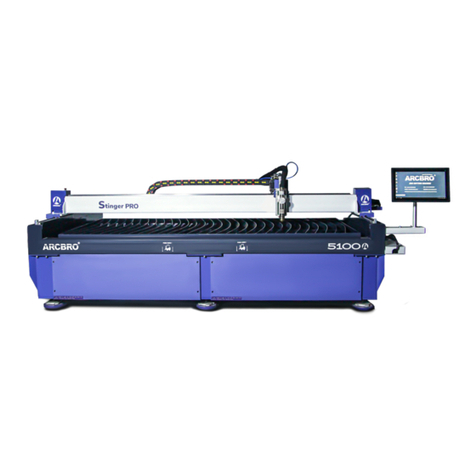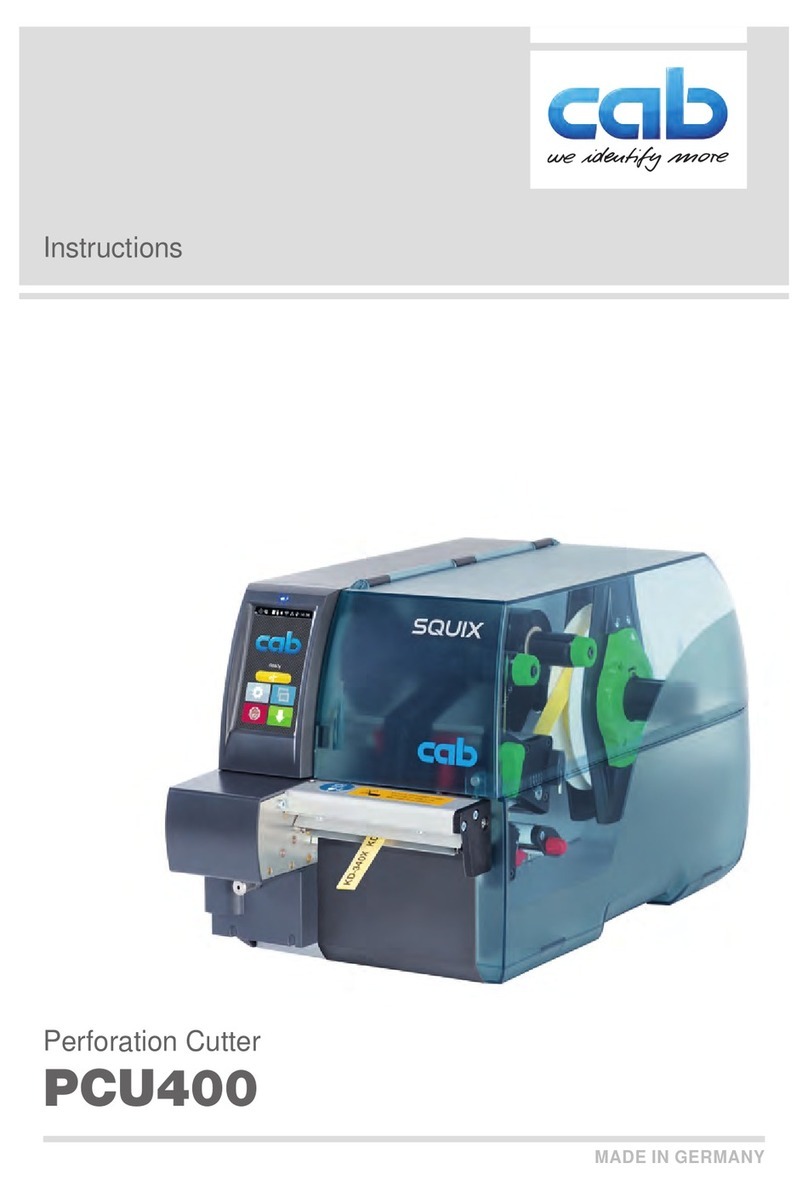
ESPAÑOL
- Activar el muelleo del palpador, para el cifrado de llaves de puntos
- Desactivar el muelleo del palpador, para el cifrado de llaves de regata.
17. Palanca apoyo tubular: Abatiendo 90º esta palanca, sirve de apoyo a la mano que
acciona la “palanca de traslación del carro”, durante el cifrado de llaves tubulares.
18. Almacén de herramientas: Accesorio que permite el almacenamiento de forma or-
denada, de las diferentes parejas de Fresas y Palpadores.
19. Protector de virutas: Evita la proyección de parte de la viruta generada durante el
duplicado, hacia el usuario de la máquina.
20. Guarda motor: Protege el sistema de transmisión de movimiento desde el motor
hasta el cabezal de giro de la Fresa.
21. Iluminación: Ilumina la zona de trabajo mediante tecnología Led.
22. Selector de velocidad: Para seleccionar la velocidad de giro de la Fresa.
- Velocidad 1 (baja), para Fresas de HSS.
- Velocidad 2 (alta). para Fresas de METAL DURO.
23. Enchufe: Para la toma de corriente eléctrica
El enchufe lleva un fusible de 6A/220V que protege ante un eventual fallo
que se pueda registrar en el circuito eléctrico.
24. Interruptor general: para poner en marcha o apagar la máquina
4.7 COMPONENTES Y PARTES FUNCIONALES
4.7.1 CAMBIO DE FRESA Y DE PALPADOR
Para soltar la fresa, hay que accionar el pulsador de bloqueo de la fresa al mismo
tiempo que con la mano hacemos girar el portaherramientas.
Después de extraer la fresa a reemplazar, introducir la nueva fresa y amarrarla en el
portaherramientas, asegurándonos de que su extremo hace tope en el interior del por-
taherramientas.
El palpador se reemplaza de la misma manera que la fresa. La única diferencia a tener
en cuenta es que el giro del palpador siempre se encuentra bloqueado internamente.
4.7.2 BLOQUEO DEL CARRO EN EL FIN DEL RECORRIDO DEL EJE “Y”
Con el objetivo de que el carro no se desplace en la dirección “Y”, durante el tiempo
que el duplicador está amarrando las llaves en la mordaza, se ha dotado al carro de un
bloqueo momentáneo en esta dirección.
Para accionar este bloqueo, basta con desplazar el carro hasta su tope de recorrido en
la dirección hacia el duplicador.
Para desactivar este bloqueo, basta con desplazar el carro hacia delante, haciendo un
poco de fuerza.
4.7.3 MORDAZA
Las prestaciones de la mordaza de la duplicadora CAPRI son superiores a las de una
máquina normal del mercado, al disponer de dos caras de amarre independientes. Ade-
más, las mordazas se pueden bloquear en cualquier posición de giro entre 45º 0º -45º.
5.- OPERATIVIDAD Y FUNCIONAMIENTO
5.1 PROCESO DE CIFRADO
• Encienda la máquina accionando el interruptor general situado en la parte trasera
derecha de la máquina.
• Para mejorar la visibilidad de la zona de trabajo, active la iluminación accionando el
interruptor situado en el display-teclado.
• Con ayuda de la tabla que se incluye en el presente manual, seleccionar la fresa y el
palpador necesarios para cifrar la llave.
• Cambiar la fresa y el palpador.
• Bloquear momentáneamente el carro en el fin de recorrido del eje “Y”.
• Amarrar la llave original en la parte izquierda de la mordaza, y la llave a cifrar en la
parte derecha. A la hora de amarrar las llaves, hay que tener en cuenta los siguientes
detalles:
- TOPE DE LA LLAVE. Puede tratarse de una llave de “tope-cuello” (Fig. 4.A),o de “to-
pe-punta” (Fig. 4.B).
- ADAPTADOR. En algún modelo de llave muy concreto, puede ser necesaria la utiliza-
ción de un adaptador.
- INCLINACIÓN. Algunas llaves tienen los puntos inclinados, por lo que será necesario
girar la mordaza.
• Hacer la regulación vertical del palpador.
• Activar los sistemas que simplifican el trabajo de duplicado:
- PALPADOR: Activar o desactivar el muelleo del palpador, en función del tipo de llave
a cifrar.
- CARRO: En función del modelo de llave, puede ser interesante activar el muelleo del
carro, o el bloqueo del carro en la dirección “X”.
- APOYO: en función del modelo de llave, puede ser interesante utilizar la palanca de
apoyo para llaves tubulares.
• Poner en marcha el giro de la fresa, eligiendo previamente una de las dos velocida-
des disponibles.
• Proceder al cifrado de la llave. Si la llave es de puntos, utilizar la ayuda del sistema
de “control de fuerza de duplicado”.
8. Fresa.
9. Palpador.
10. Mordaza.
11. Diodos LED de Iluminación.
12. Sensor de fuerza.
Ver Figura 2
4.5 DATOS TÉCNICOS
Motor: Monofásico 400 W. ,230 V - 50 Hz (Opcional: Monofásico 400W, 110V – 60Hz)
Fresa: HSS (Opcional: Metal duro)
Velocidad fresa: 6.000 y 11.000 r.p.m.
Mordazas: De dos caras de amarre y basculantes 0 / 45 º
Desplazamiento: En tres ejes con guías de rodillos de precisión.
Cursos útiles: Eje X = 71 mm; eje Y = 62 mm; eje Z = 40 mm
Iluminación: Diodos Led
Dimensiones: Ancho = 430 mm, Profundidad = 385 mm y Alto = 485 mm
Peso: 25 Kg
4.6 ELEMENTOS PRINCIPALES DE LA MÁQUINA
A continuación se describen los principales elementos de los que consta la máquina:
Ver figuras 3A y 3B
1. Display-teclado: Con las siguientes funcionalidades:
- Interruptor de iluminación: Activa y desactiva la iluminación de la zona de trabajo.
- Interruptor general del Display-teclado: Activa y desactiva las funcionalidades
del display-teclado.
- Indicador led luminoso:
Si se encuentra en color rojo, indica que la máquina está en marcha. Pero
las funcionalidades del display-teclado están desactivadas.
Si se encuentra en color verde, además de estar la máquina en marcha,
también están activadas las funcionalidades del display-teclado.
- Indicador de muelleo del palpador: Si está iluminado indica que el sistema de
muelleo del palpador está activado. Si está apagado, el sistema está desactivado.
- Interruptor MODE: Activa o desactiva el sistema luminoso de regulación de altura
de la Fresa y Palpador.
- Barra de leds: Indicador luminoso de la fuerza vertical ejercida por las herramien-
tas durante el cifrado de llaves de puntos. NOTA: Cuando se alcanza la fuerza ideal, la
máquina emite un sonido.
- Flechas: Indican el sentido hacia el que hay que girar el “Regulador altura Fre-
sa-Palpador” para efectuar el reglaje. La altura Fresa-Palpador está ajustada cuando se
iluminan al mismo tiempo las dos luces azules situadas junto a sus correspondientes
flechas.
2. Carro porta-mordazas: para el desplazamiento de la mordaza en las direcciones X e
Y mediante guías de precisión.
3. Palanca de traslación del carro: para desplazar el carro de tal manera que los diferen-
tes puntos de la llave se coloquen frente a la fresa.
4. Cabezal: para el desplazamiento vertical de la fresa y palpador (dirección Z).
5. Palanca de traslación del cabezal: para desplazar el cabezal hacia abajo durante la
fase de duplicado.
- Girándola en sentido horario, también sirve para bloquear el cabezal a la altura
deseada (necesario para duplicar llaves de regata).
Durante el duplicado es OBLIGATORIO tener las manos ocupando la palan-
ca de traslación del carro (3) y la palanca de translación del cabezal (5).
6. Pomo muelleo carro: para activar y desactivar el sistema de muelleo del carro en la
dirección X. Muy útil para el cifrado de llaves de regata.
7. Pomo bloqueo carro: para bloquear el carro en la dirección X. Muy útil en el cifrado
de llaves de puntos, para el cifrado de una hilera de puntos.
- Para activar este bloqueo, también debe estar activado el “Pomo de muelleo
carro”.
8. Mordaza:
- Giratorias.
- Con 2 lados de amarre.
- Con garras reemplazables.
9. Maneta mordaza: Para la apertura y cierre de las garras.
10. Maneta bloqueo giro mordaza: para bloquear el giro de la mordaza en el ángulo
requerido.
11. Porta-herramientas: Facilita el amarre de las herramientas (Fresa y Palpador) de una
manera rápida, cómoda y precisa.
12. Fresa: Fabricada en acero de alta velocidad HSS. Están disponibles fresas con di-
ferentes geometrías en función de la geometría de los puntos o ranuras de la llave a
duplicar.
13. Pulsador bloqueo fresa: para bloquear manualmente el giro de la fresa en el mo-
mento del intercambio de fresa.
14. Palpador: Específico para leer el cifrado de la llave. El palpador a utilizar debe ser la
pareja de la Fresa requerida para cada duplicado concreto.
15. Regulador altura Fresa-Palpador: para desplazar verticalmente la posición del Pal-
pador en el momento de realizar la regulación de altura entre Fresa y Palpador.
16. Maneta muelleo palpador: para activar y desactivar el sistema de muelleo del Pal-
pador.






